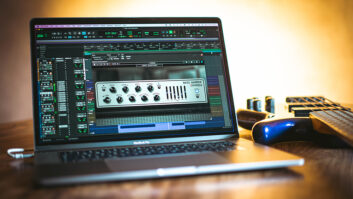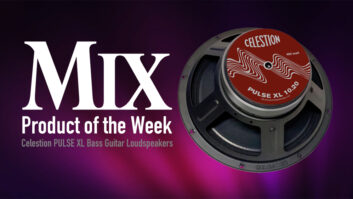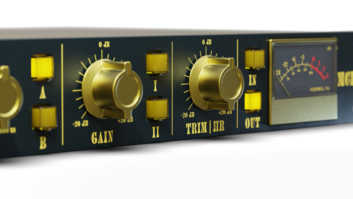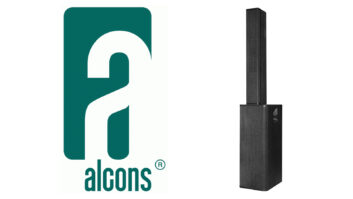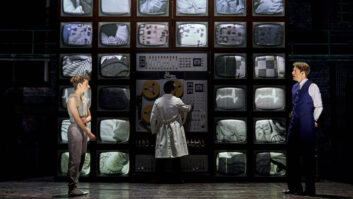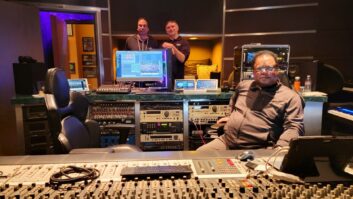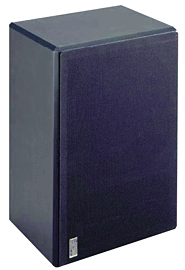

With more than 1,000 room tunings under my belt, I’ve developed a wish list of tools to help me do a better job. For years, a tunable bass trap has been at the top of that list. It would be nice to measure a room, apply the fix and walk away knowing that the problem is solved. Two situations cry out for this type of tool. First is a completed control room that still has some existing low-frequency issues, and the prospect of tearing the room apart is undesirable and beyond the budget. The second is a small control room (often a home studio) where the use of traditional bass traps is not possible due to a lack of space. Bag End’s E-Trap™ has the possibility of addressing both these scenarios.
The E-Trap acts as an acoustical absorber in electronic form. By using feedback into a built-in loudspeaker, the transducer behaves with the same dynamics as a membrane absorber. The unit can attack high-Q resonances that are destructive to the room response — both at the offending frequency, but also because these tend to mask other frequencies around them. Holes in the frequency response can be caused by frequencies bouncing off boundaries and returning out of phase to the mix position. The E-Trap can reduce the resonance amplitude and ringing (Fig. 1), as well as reduce a reflection that could cause cancellation at the mix position.
E-Trap’s enclosure is a compact 18×13×10 inches, allowing placement in the most effective position without significantly impacting room aesthetics. The E-Trap is designed to address two separate problem frequencies simultaneously (as long as the box position is in the high-pressure location for both). Four rotary pots let users set desired frequency (coarse and fine controls), contour (think of this as Q plus feedback) and the amount of feedback (damping) for each offending resonance. A switch selects whichever of two sampling microphones (front or back of the cabinet) you find most effective, and another switch turns on/off the two channels. A mini-plug for the E-Trap mic’s output is also provided, but this was not tested.
While E-Trap includes Windows PC measurement software, it was not tested in this review. If you don’t use that software, Bag End recommends using an FFT analyzer with 0.5Hz resolution. I used the Meyer SIM 3 system, a dual-channel FFT that operates at 1/48th-octave resolution.
IN THE FIELD

Fig. 1: A test signal of alternating on/off sine wave tones (starting at 27 Hz and raising 1 Hz each time it turns on to 40 Hz) was played in a room. The blue trace is the undamped response in the room. The red trace is the response with the E-Trap enabled.
I tested the E-Trap in two completely different rooms and learned that achieving proper results requires several hours. This box is not simple to adjust because the problem you’re trying to solve is not simple. The first step is finding the high-pressure points in the room for the frequency you’re trying to tame. This involves measuring the room in corners, along walls and along the floor and ceiling to identify the E-Trap’s optimal placement. By placing your measurement mic in another high-pressure zone, you can see the same basic adjustment results. In symmetrical rooms, this is generally on an opposite boundary, but in odd-shaped rooms the mix position is a reasonable spot. The problems I was trying to control weren’t subtle, so I could easily hear the E-Trap’s effect at the mix position. I wasn’t going after the resonance-causing frequency peaks, but was trying to fill in holes in the speaker response at the listening position in both rooms.
Once the E-Trap is placed, the tuning process is difficult and, on occasion, counterintuitive. (Sometimes more damping can be achieved by actually turning down the amount of feedback.) Bag End recommends a starting point for the controls, but then it’s open season for experimentation. Starting with the recommended settings, I narrowed in on the offending frequency with the Coarse control pot and zeroed in with the Fine pot. If you go over the top with your adjustments, the box howls with unstable feedback. I don’t think of this as a negative — more of a less-than-subtle warning.
My first room was probably an unfair test — frankly, the room needed some kind of miracle, with its deep and very wide hole in the low end. I believe the problem was due to room dimensions, but there may be other issues behind the room’s false ceiling. Still, I was able to identify the problem area. I could correct a few dB at the offending frequency, although not enough to justify installing the E-Trap.
The next room I tackled was an oddly shaped home studio garage conversion with a huge hole at 50 Hz and a peak at 63 Hz. After much experimentation, the E-Trap ended up mounted against the front wall about halfway up and a few feet out from the corner. Some considerable knob-turning yielded dramatic results. In Fig. 2, the yellow trace shows the room response prior to setting the E-Trap and the maroon trace shows the tuned result. I restored a massive 13 dB of energy at 50 Hz. I also went after the 63Hz peak, but found that I could not maintain the great results at 50 Hz if I pulled down the 63Hz peak. This may be due to the problem areas’ center frequencies being too close together (as Bag End states in the literature) or due to the fact that the physical placement of the trap was not optimized for the higher frequency.

Fig. 2: Small mix room before use of E-Trap (yellow trace) compared to after E-Trap placement and
adjustment (maroon trace)
Once you have the box tuned, the settings can be protected by carefully pushing the pots into the panel. But what happens if there is a failure in the electronics? If the pots were stepped, then you could duplicate the settings on another unit. But at this time, the only alternative is repeating the tuning process. The pots’ settings are critical, and I don’t think you could eyeball the pots into place on a replacement unit.
At a retail of $1,598, E-Trap is not intended to replace conventional bass traps in traditionally designed studios. However, in those rooms with low-end problems where it is impractical to do a renovation, it may prove to be a good cost-effective acoustic fix. It’s also a good choice where the space limitations restrict the use of large passive absorbers. The fact that it allows experimentation makes it a flexible tool for taking the guesswork out of some nasty room solutions. As a word of caution to the D.I.Y.’er: I strongly feel that this box will be most effectively set up by someone who knows how to use sophisticated measurement tools and has some understanding of room acoustics.
Bag End, 847/382-4550, www.bagend.com.
Bob Hodas tunes studios around the world, from Sony in Tokyo to Abbey Road in London and all parts in between. His Website is woefully behind, but it can be found at
www.bobhodas.com.

READ: White Paper
READ: In Use
